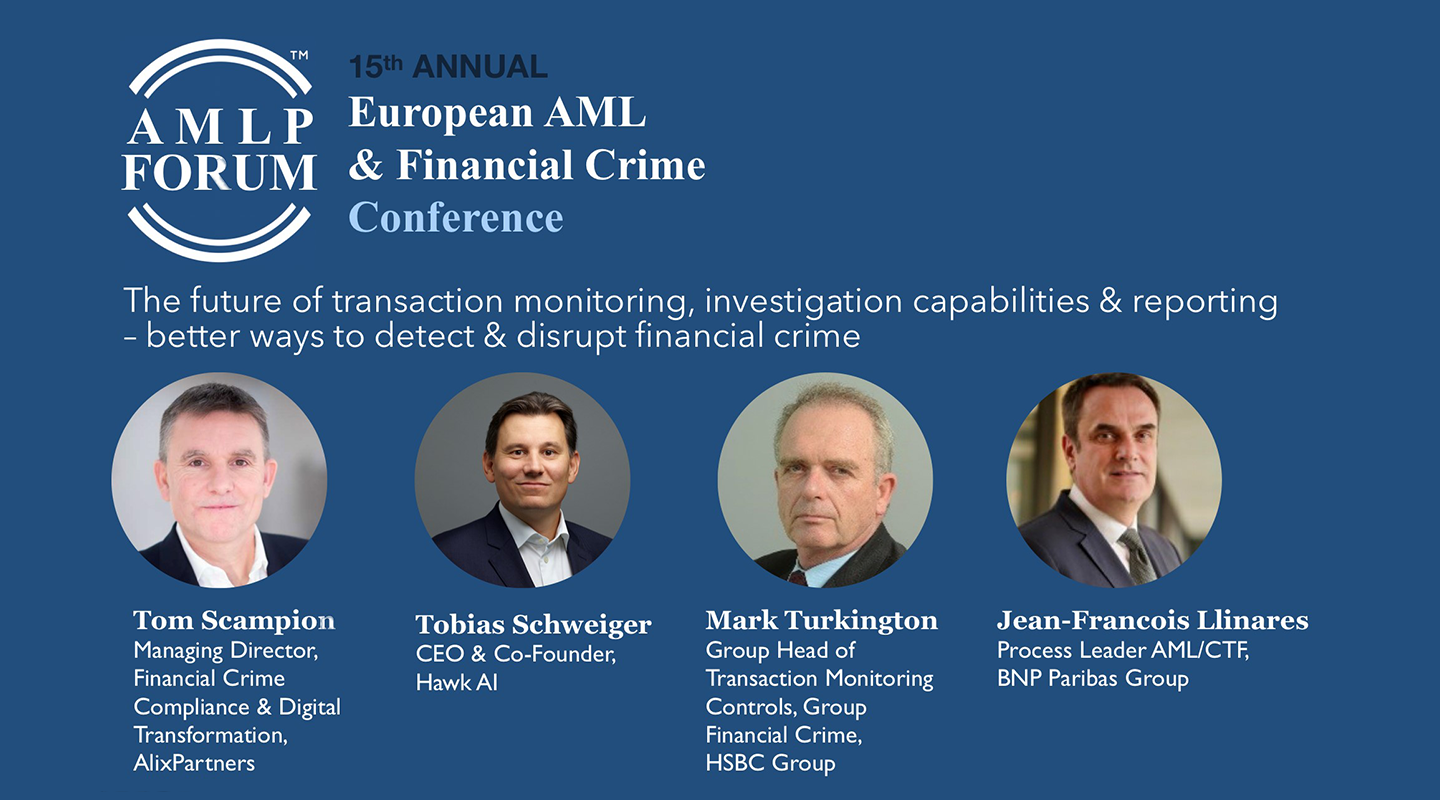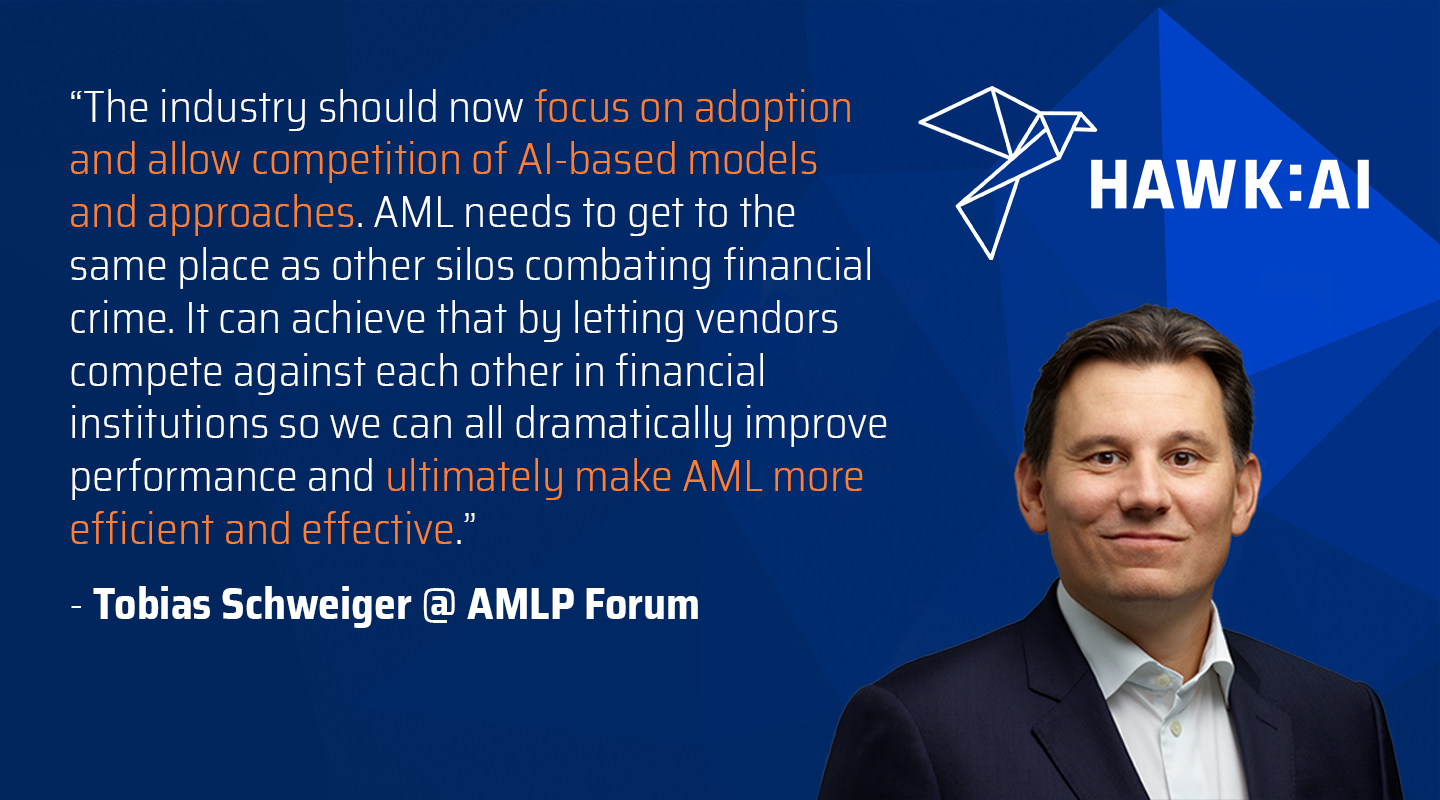HAWK:AI on the future of transaction monitoring – a panel discussion at the European AML & Financial Crime Conference

On 18 November, our CEO Tobias Schweiger voiced key considerations on “Building future state of transaction monitoring & reporting – emerging ways to detect & disrupt financial crime”.
Speaking at the AMLP Forum's 15th annual European AML & Financial Crime Conference, Tobias was on the panel alongside Mark Turkington, Group Head of Transaction Monitoring Controls, Group Financial Crime, HSBC Group, and Jean-Francois Llinares, Process Leader AML/CTF, BNP Paribas Group, moderated by Tom Scampion of Alix Partners.
Below are some of the key highlights of the session:
The worrying state of AML
Tom kicked off the session and set the scene with worrying figures of the state of AML, namely:
- Less than 1% of laundered funds are seized (UNODC, 2011)
- 85-95% of SARS don't lead to effective disruption of Financial Crime (RUSI, 2017)
- In Europe, over €100bn is spent on compliance in the Financial Crime sector, and roughly 10% of all banks’ staff dedicated to this task (European Banking Federation, 2020)
With Transaction Monitoring as arguably the front line in combating this epidemic of financial crime, the discussion focused on two areas: Where are we today? And what does the future hold for us?
Risk assessment, the emergence of novel technologies like crypto, and chain vs. FIAT considerations
Mark kicked off the discussion noting that “risk assessment is an area we as an industry traditionally get wrong.” He goes on to elaborate that if compliance teams don’t have a good handle on what specific risks they face, they won’t be able to understand their points of vulnerability and put the correct control points in place.
Risk assessment is key, especially when considering emerging technologies. Jean-Francois elaborated that new risks, like crypto, are driven by client interest with regulations evolving to keep up with the market.
Tobias noted the right amount of focus is on crypto right now, but was quick to point out the process of learning to adapt to these new technologies (and risks) is slow. A key point is to consider the “onramps” and “offramps” between crypto and traditional FIAT currencies which pose a more traditional transaction monitoring challenge.
Pushing for an integrated and complete client view
“KYC is usually what clients have told us about themselves, while the info we gather from transacting behavior shows what they do and who they are,” according to Mark. “When looking for anomalies that point to AML, you look for the difference between these two.”
Mark elaborated on the need for a “360 view” into the process, which is currently not the case. Using Money Mules as an example, he highlights that this one case could be a fraud problem, an AML problem, and a sanctions problem at the same time. Rather than looking at technology to address regulations and tackle these problems as isolated verticals, we should consider how we can consolidate and be more efficient. “The industry hasn’t gone far enough,” states Mark.
Tobias elaborates that this is a key issue HAWK:AI sees as a technology provider to the industry. “From a tech standpoint, financial institutions (FIs) want (or certainly need) a tool that covers more than one risk category. Without this approach, they can’t manage their workflow and can’t connect the dots from a detection perspective. Rather than running different risk management systems in each silo, a more overarching view is required from an organization and technology perspective.” Interestingly, Tobias notes that smaller, newer organizations, are much closer to this consolidated way of working, particularly when it comes to combining Fraud and AML efforts. Their modern organization layout sits in contrast to larger banks which have typically developed specific hierarchies over decades and now face a far greater restructuring challenge.
Jean-Francois highlighted this as an area where AI and automation can drive continuous improvement in the process. “New technology enables network analytics to graph clients and dependencies. This really brings KYC and external data into the conversation to improve anomaly detection.”
Everything starts with data, the challenge is to cut through the noise and create precise monitoring
Coming as no surprise, data was a key topic during the discussion. “If you don’t get your data right you’ll always be second-guessing yourself, even with the best scenario design,” according to Mark. He points out that a weakness of rules-based monitoring is you’re using historical patterns and behaviors to predict the future. However, if you have your customer understanding wrong or their behavior changes, you end up with a fuzziness that may end up triggering the wrong kind of alerts in the system.
Tobias comments that the current AML journey is one of augmenting classic rules-based systems with AI. Before integration, companies should start with analytics, particularly expanding data sets- with more relevant points to achieve the precision Mark mentioned. “Things like device fingerprints, geolocation and more, in context, help us extend the datasets used to create segments based on understanding consumer behaviors, rather than traditional ‘hard’ segmentation.”
Once data is expanded, then we can move on to integration according to Tobias. “An example would be modern AI-powered systems being able to integrate with legacy systems in a bi-directional manner. That way the modern system understands when the legacy system is triggering alerts, and why these alerts are triggered. Similarly, the legacy system can benefit from the modern system’s AI models to reduce false alerts and spot anomalies before they become widespread.”
Jean-Francois rounds this out by discussing how BNP Paribas aims to find the best solutions per business line to drive effectiveness, rather than having one central system that sits across all lines. While they currently use rule-based systems, the company is investigating more sophisticated technology.
The impact of modern AML technology, and the hurdles it faces
Mark once again kicked off the discussion, proposing that the first step for next-generation technology is reducing the noise created by rules in post-detection work. “Reducing the fuzziness and adding more precision to what you actually want humans to look at is key,” says Mark.
He elaborates that new technologies are good at detecting anomalies when you point them in the right direction. “Rule-based transaction monitoring is finding what you’re looking for. AI-powered transaction monitoring is about finding things you don’t yet know about.” With a visual metaphor, Mark notes: “You’re not just finding needles, you’re finding things and you don’t know what they are. These could be new typologies that you haven’t yet come across.”
That being said, Tobias noted modern AML solutions have been around for a few years, and the focus should now be on how FIs can adopt these technologies as soon as possible. “FIs should consider a mindset of trying new things out and seeing what the impact will be. The largest banks in the world have the resources and appetite to try this out, however, these same resources (and experience) aren’t always available in smaller organizations. This is a key area where vendors can step in as expert partners to accelerate the process.”
Tobias mentions a common specific hurdle faced is how cloud technology is not always well-perceived by FIs. However, with the growth of cloud-based analytics in these organizations, this is hopefully a barrier that won’t slow adoption for much longer.
Finally, FIs should consider “trying things out in the journey to implementation.” This may mean accepting slightly less explainability in the beginning (before deployment, Tobias stressed) to see what benefits AI-powered systems can bring. Once the benefits are realized in the pilot stage, FIs can work with tech providers to ensure transparency, trust, and explainability so that everyone involved, from the business to the regulators, trusts the new systems.
Final thoughts for the future of AML transaction monitoring
Bringing the session to a close, the panelists had these final thoughts to share:
Mark: “In a few years we want to avoid the scenario where the regulator says ‘you had data and access to technology, and you understand the risk. Why didn’t you put those 3 together?’ We don’t have a choice, we need to get answers to those questions.”
Tobias: “The industry should now focus on adoption and allow competition of AI-based models and approaches. AML needs to get to the same place as other silos combating financial crime. It can achieve that by letting vendors compete against each other in financial institutions so we can all dramatically improve performance and ultimately make AML more efficient and effective.”
Jean-Francois: “We can’t abandon rules right away. We should of course enhance detection with AI, but keep rule-based systems in place alongside the AI and, perhaps over time, the influence of rules shrinks while AI’s influence grows.”
